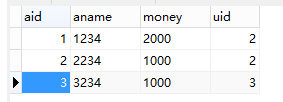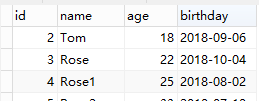mybatis 一对一 一对多 多对多
一对一
account users


1 . account 继承users
accountMapper.xml 中配置 resultMap ,映射user中的属性
<resultMap id="accounts" type="account">
<id property="a_id" column="aid"></id>
<result property="aname" column="aname"></result>
<result property="money" column="money"></result>
<result property="uid" column="uid"></result>
<!--映射user-->
<result property="uid" column="id"></result>
<result property="username" column="name"></result>
<result property="age" column="age"></result>
<result property="birthday" column="birthday"></result>
</resultMap>
<!--查询所有-->
<select id="FindAll" resultMap="accounts">
select * from account a,users u
where a.aid = u.id
</select>
2 . account 中包含user属性
用association 关联一个对象
association 关联对象的映射, 只能关联一个对象
property: 映射属性名
javaType: 加载对象的java数据类型
<resultMap id="accounts" type="account">
<id property="a_id" column="aid"></id>
<result property="aname" column="aname"></result>
<result property="money" column="money"></result>
<result property="uid" column="uid"></result>
<!--映射user-->
<association property="user" javaType="user">
<id property="uid" column="id"></id>
<result property="username" column="name"></result>
<result property="age" column="age"></result>
<result property="birthday" column="birthday"></result>
</association>
</resultMap>
<!--查询所有-->
<select id="FindAll" resultMap="accounts">
select * from account a,users u where a.aid = u.id
</select>
3 . 使用user引用user中的属性名
<resultMap id="accounts" type="account">
<id property="a_id" column="aid"></id>
<result property="aname" column="aname"></result>
<result property="money" column="money"></result>
<result property="uid" column="uid"></result>
<!---user对象的映射: 使用user来引用user中的属性名-->
<result property="user.uid" column="id"></result>
<result property="user.username"
column="name"></result>
<result property="user.age" column="age"></result>
<result property="user.birthday"
column="birthday"></result>
</resultMap>
<!--查询所有-->
<select id="FindAll" resultMap="accounts">
select * from account a,users u where a.aid = u.id
</select>
一对多
user表和account表
一个用户有多个账户:在用户中定义一个账户集合
private List<Account> accountList = new ArrayList<Account>();
collection:关联多个对象
accountList: 映射的属性名
ofType:关联的类型
<mapper namespace="com.wqy.mapper.UserMapper">
<resultMap id="users" type="user">
<id column="id" property="uid"></id>
<result column="name" property="username"></result>
<result column="age" property="age"></result>
<result column="birthday" property="birthday"></result>
<!--映射account-->
<collection property="accountList" ofType="account">
<id property="a_id" column="aid"></id>
<result property="aname" column="aname"></result>
<result property="money" column="money"></result>
<result property="uid" column="uid"></result>
</collection>
</resultMap>
<!--查询所有-->
<select id="findAll" resultMap="users">
select * from users u
,account a where u.id = a.uid
</select>
多对多
用户表:users 角色表role 中间表 users_role



即两个一对多
在用户对象中添加属性:
private List<Role> roleList = new ArrayList<Role>();
在角色对象中添加属性:
private List<User> userList = new ArrayList<User>();
注解
@Insert:实现新增
@Update:实现更新
@Delete:实现删除
@Select:实现查询
@Result:实现结果集封装
@Results:可以与@Result 一起使用,封装多个结果集
@One:实现一对一结果集封装
@Many:实现一对多结果集封装
@SelectProvider: 实现动态 SQL映射
@Result:实现结果集封装
@Results:可以与@Result 一起使用,封装多个结果集
/**
* 查询全部
* @return
* @Results:映射结果集:多列数据
* @Result:映射单列的数据
* id:是否为主键:true:为主键 false:不是主键
* 如果列名与属性名不一致,必须配置
* 如果列名与属性名一致,则可以不配置
*/
@Results({ @Result(id = true,property = "uid",column = "id"), @Result(property = "username",column = "name") }) @Select("select * from users") List<User> findAll();
@Results 注解
代替的是标签<resultMap>
该注解中可以使用单个@Result 注解,也可以使用@Result 集合
@Results({@Result(),@Result()})或@Results(@Result())
@Resutl 注解
代替了 <id> 标签和<result> 标签
@Result 中 属性介绍:
column 数据库的列名
Property 需要装配的属性名
one 需要使用的@One 注解(@Result(one=@One)()))
many 需要使用的@Many 注解(@Result(many=@many)()))
@One 注解(一对一 )
代替了<assocation> 标签,是多表查询的关键,在注解中用来指定子查询返回单一对象。
@One 注解属性介绍:
select 指定用来多表查询的 sqlmapper
fetchType 会覆盖全局的配置参数 lazyLoadingEnabled 。。
使用格式:
@Result(column=" ",property="",one=@One(select=""))
Account中有User属性
private User user;
public interface AccountMapper {
@Results({
@Result(id=true,property = "a_id",column = "aid"),
@Result(property = "user",column = "uid",one=@One(select = "com.wqy.mapper.UserMapper.findUserByid",fetchType = FetchType.LAZY))
})
@Select("select * from account ")
List<Account> FindAll();
}
uid为account表中的外键字段,根据uid去查用户
public interface UserMapper {
@Results({
@Result(id = true,property = "uid",column = "id"),
@Result(property = "username",column = "name"),
})
@Select("select * from users where id = #{id}")
User findUserByid(Integer id);
}
@Many 注解(多对一)
User 中的属性
private List<Account> accountList = new ArrayList<Account>();
代替了<Collection> 标签, 是是多表查询的关键,在注解中用来指定子查询返回对象集合。
注意:聚集元素用来处理“一对多”的关系。需要指定映射的 Java 实体类的属性,属性的 javaType(一般为 ArrayList)但是注解中可以不定义;
使用格式:
public interface UserMapper {
@Results({
@Result(id = true,property = "uid",column = "id"),
@Result(property = "username",column = "name"),
@Result(property = "accountList",column = "uid",javaType = List.class,
many = @Many(select = "com.wqy.mapper.AccountMapper.FindAllByUid"))
})
@Select("select * from users ")
List<User> findAll();
}
public interface AccountMapper {
@Results({
@Result(id=true,property = "a_id",column = "aid")
})
@Select("select * from account ")
List<Account> FindAllByUid(Integer id);
}
@SelectKey
/**
* selectKey:查询主键值
* 属性:keyColumn:表中的列名
* keyProperty:pojo的属性名
* before: 在添加之前查询,还是在之后查询,true:在之前查询,false:在之后查询
* resultType:返回值类型
* statement: sql语句
*/
@Results({ @Result(id = true,property = "uid",column = "id"), @Result(property = "username",column = "name") }) @SelectKey(keyProperty = "uid",keyColumn = "id",before = false, resultType = Integer.class,statement = {"select last_insert_id()"}) @Insert("insert into users values (null,name,age,birthday)") void save(User user);
/**
* 查询全部
* @return
* @Results:映射结果集:多列数据
* @Result:映射单列的数据
* id:是否为主键:true:为主键 false:不是主键
* 如果列名与属性名不一致,必须配置
* 如果列名与属性名一致,则可以不配置
* @Result:如果映射的一对一
* javaType:属性对应的类型是什么
* property:属性名
* column:表的列名
* one: 对应一条记录
* @One(select = "com.itheima.dao.UserDao.findByUid"):去查询一个对象返回
* 属性:fetchType:默认为立即加载
* 可以配置为:FetchType.LAZY: 延迟加载,只有在使用的时候才会加载该对象
*/
动态SQL:
public class UserProvider {
public String findByConditionSql(String name, Integer age) {
StringBuilder sb = new StringBuilder();
sb.append("select * from users where 1=1 ");
if (name != null && name != "") {
sb.append(" and name = \"%\"#{param1}\"%\" ");
}
if (age != null) {
sb.append(" and age > #{param2}");
}
return sb.toString();
}
}
// @Select("select * from users where
name like \"%\"#{param1}\"%\" and age > #{param2}"
)
@SelectProvider(type = UserProvider.class,method = "findByConditionSql")
List<User>
findBycondition(String name,Integer age);





